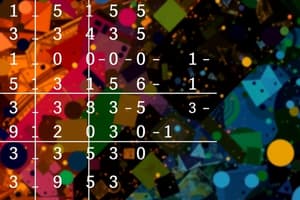Podcast
Questions and Answers
What is the unit of output represented by the letter "Q" in the table?
What is the unit of output represented by the letter "Q" in the table?
Quantity of Products
What is the formula for calculating total revenue when TR = P x Q?
What is the formula for calculating total revenue when TR = P x Q?
Total Revenue = Price per product x Quantity of Products
What does the formula MR = ΔTR/ ΔQ represent?
What does the formula MR = ΔTR/ ΔQ represent?
Marginal Revenue
What is the formula for Average Revenue?
What is the formula for Average Revenue?
When does the firm in a perfectly competitive market have constant marginal revenue?
When does the firm in a perfectly competitive market have constant marginal revenue?
What is the formula used to calculate total revenue?
What is the formula used to calculate total revenue?
The demand curve in a perfectly competitive market is perfectly elastic.
The demand curve in a perfectly competitive market is perfectly elastic.
What is the relationship between AR, MR, and P in the perfectly competitive market?
What is the relationship between AR, MR, and P in the perfectly competitive market?
What type of market is displayed in the table where TR = P x Q?
What type of market is displayed in the table where TR = P x Q?
What is the difference between explicit costs and implicit costs?
What is the difference between explicit costs and implicit costs?
What is the name of the costs that are directly incurred, such as payments for wages, materials, or rent?
What is the name of the costs that are directly incurred, such as payments for wages, materials, or rent?
What is the formal term for the opportunity cost of using resources in a particular way?
What is the formal term for the opportunity cost of using resources in a particular way?
What is the sum of explicit costs and implicit costs?
What is the sum of explicit costs and implicit costs?
Flashcards
Perfect Competition
Perfect Competition
A market structure with many buyers and sellers, homogeneous products, and free entry/exit.
Total Revenue (TR)
Total Revenue (TR)
Total earnings from selling a certain quantity of goods.
Marginal Revenue (MR)
Marginal Revenue (MR)
Extra revenue from selling one more unit.
Average Revenue (AR)
Average Revenue (AR)
Signup and view all the flashcards
Explicit Costs
Explicit Costs
Signup and view all the flashcards
Implicit Costs
Implicit Costs
Signup and view all the flashcards
Economic Costs
Economic Costs
Signup and view all the flashcards
Monopoly
Monopoly
Signup and view all the flashcards
Oligopoly
Oligopoly
Signup and view all the flashcards
Market Power
Market Power
Signup and view all the flashcards
Market Failure
Market Failure
Signup and view all the flashcards
Public Goods
Public Goods
Signup and view all the flashcards
Externalities
Externalities
Signup and view all the flashcards
Positive Externality
Positive Externality
Signup and view all the flashcards
Negative Externality
Negative Externality
Signup and view all the flashcards
Allocative Efficiency
Allocative Efficiency
Signup and view all the flashcards
Common Pool Resources
Common Pool Resources
Signup and view all the flashcards
Tragedy of the Commons
Tragedy of the Commons
Signup and view all the flashcards
Study Notes
Perfect Competition
- Firms are price takers
- Large number of buyers and sellers
- Homogenous products (identical)
- No barriers to entry or exit
- Perfect knowledge
- Constant profit in the long run
Revenue Curves
-
Total Revenue (TR): Price multiplied by Quantity (TR = P x Q)
-
Average Revenue (AR): Total revenue divided by quantity (AR = TR/Q)
-
Marginal Revenue (MR): Revenue arising from the sale of an additional product unit, (MR = ΔTR/ΔQ).
-
In perfect competition, AR = MR = P (price)
Studying That Suits You
Use AI to generate personalized quizzes and flashcards to suit your learning preferences.



